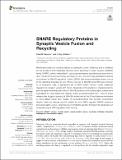SNARE Regulatory Proteins in Synaptic Vesicle Fusion and Recycling
Author(s)
Sauvola, Chad W; Littleton, J Troy
DownloadPublished version (1.922Mb)
Publisher with Creative Commons License
Publisher with Creative Commons License
Creative Commons Attribution
Terms of use
Metadata
Show full item recordAbstract
<jats:p>Membrane fusion is a universal feature of eukaryotic protein trafficking and is mediated by the soluble <jats:italic>N</jats:italic>-ethylmaleimide sensitive factor attachment protein receptor (SNARE) family. SNARE proteins embedded in opposing membranes spontaneously assemble to drive membrane fusion and cargo exchange <jats:italic>in vitro</jats:italic>. Evolution has generated a diverse complement of SNARE regulatory proteins (SRPs) that ensure membrane fusion occurs at the right time and place <jats:italic>in vivo</jats:italic>. While a core set of SNAREs and SRPs are common to all eukaryotic cells, a specialized set of SRPs within neurons confer additional regulation to synaptic vesicle (SV) fusion. Neuronal communication is characterized by precise spatial and temporal control of SNARE dynamics within presynaptic subdomains specialized for neurotransmitter release. Action potential-elicited Ca<jats:sup>2+</jats:sup> influx at these release sites triggers zippering of SNAREs embedded in the SV and plasma membrane to drive bilayer fusion and release of neurotransmitters that activate downstream targets. Here we discuss current models for how SRPs regulate SNARE dynamics and presynaptic output, emphasizing invertebrate genetic findings that advanced our understanding of SRP regulation of SV cycling.</jats:p>
Date issued
2021Department
Picower Institute for Learning and Memory; Massachusetts Institute of Technology. Department of Brain and Cognitive Sciences; Massachusetts Institute of Technology. Department of BiologyJournal
Frontiers in Molecular Neuroscience
Publisher
Frontiers Media SA